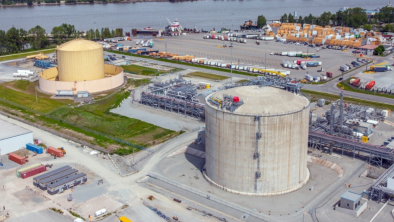Fortis B.C. LNG expansion proposal in Delta under scrutiny in environmental review
The Province

Fortis B.C. sees promise in prospect of fuelling ships with LNG but project faces opposition on climate concerns.
Fortis B.C. wants to expand the small liquefied natural gas plant on Tilbury Island in Delta, which has already begun exporting a trickle of the hydrocarbon offshore while LNG Canada has just begun construction of its massive $18-billion export facility at Kitimat.
Fortis B.C.’s $3-billion project, which would involve a more-than-10-fold expansion from its existing production, would still be a fraction of LNG Canada’s proposed output.
But the Phase 2 expansion would increase LNG storage capacity at Tilbury, which Fortis B.C. views as necessary, and could potentially tap into rising demand for LNG as fuel for ships, said Ian Finke, director of LNG operations for Fortis B.C.
“It’s a pretty big consideration,” Finke said about the marine fuel option. “We’re in discussions with a number of potential customers” due to new rules to reduce emissions from ships adopted by the International Maritime Organization.
“That’s really driving a lot of the big shipping companies to need to look at using cleaner-burning fuels for their ships. And so that’s really creating a lot of market demand,” Finke said.
A small amount of LNG, transported via specialized tanks the size of shipping containers, has been exported to China since 2017, Finke said. The bigger opportunities for using LNG as fuel in shipping or export would come with a separate project for a marine jetty adjacent to the Tilbury LNG plant.
In February, Fortis B.C. submitted a draft of the expansion for review by the B.C. Environmental Assessment Office and the Impact Assessment Agency of Canada, and is now in the middle of a public engagement period related to the document.
And the proposal does face opposition on issues ranging from the climate impacts of LNG to safety.
“There’s a list, but the biggest one is the location,” said LNG critic Eoin Finn. “This is a terrible place to put an LNG plant, opposite an industrial terminal, and where the supply tankers and barges will have to go past highly populated areas of Richmond and Delta.”
Finn, who has worked on LNG issues for the past six years, has joined a half-dozen environmental and social-action groups under the banner of Friends of Tilbury to oppose the project in the environmental review.

The Wilderness Committee is another of the groups involved, which, on June 24, contributed to what they referred to as an “alternative open house” via Zoom.
“I would say our top concern are the upstream impacts,” said Peter McCartney, climate campaigner for the Wilderness Committee.
Today, Fortis B.C.’s Tilbury plant produces some 250,000 tonnes of LNG per year, after the first part of its expansion opened in 2018. The second half of Phase 1 is due to be complete in 2022, which could bring that up to 900,000 tonnes.
Phase 2 would add up to 3.5 million tonnes of LNG production, Finke said, for a total of 4.4 million tonnes, about one-third the size of the first phase of LNG Canada’s project that is under construction.
Still, McCartney estimated that fuelling Fortis B.C.’s expansion would require 2,800 new, hydraulically fractured gas wells to be drilled in northeastern B.C.
“(That has) a massive climate impact in fugitive methane emissions from these wells,” McCartney said, before considering the downstream impacts of burning natural gas.
The official environmental assessment process has held two online open houses and the public comment period will remain open until July 16.
Finke said Fortis B.C. is confident in the safety measures being designed into the project proposal, which is on a site that has operated safely since 1971.
He added that Fortis B.C. will incorporate responses to the first public engagement process into a revised, detailed project description it intends to file later this year.
To view the original article published by The Province, please click here.


